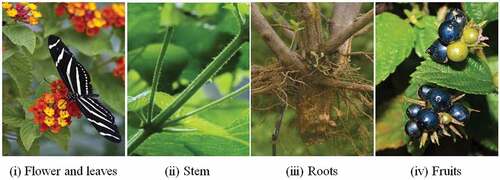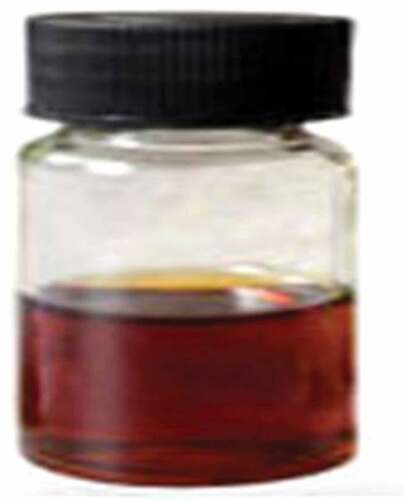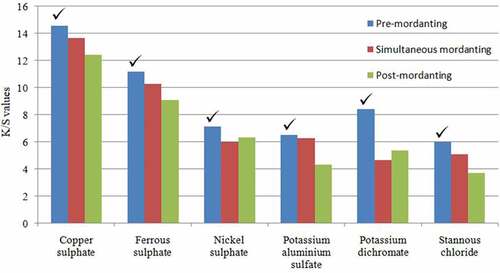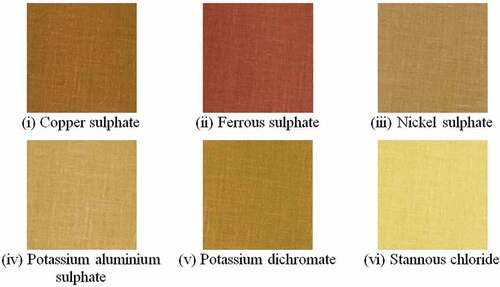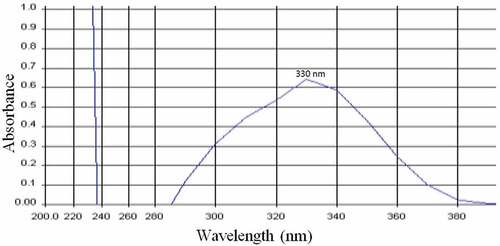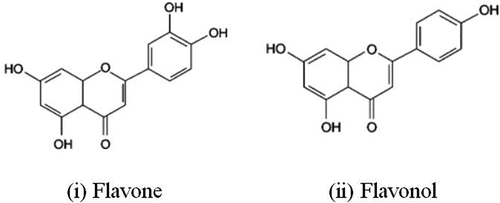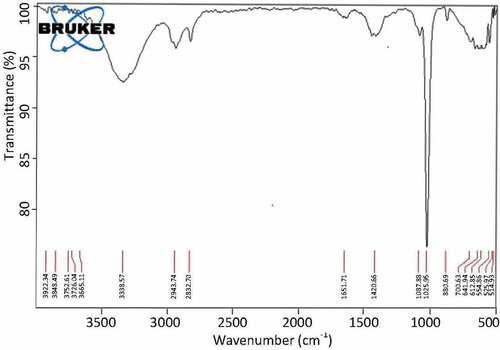ABSTRACT
Environmental concerns about synthetic dyes and their carcinogenic properties renewed interest in eco-friendly natural dyes. Natural dyes produce a wide range of tints and shades with the same dye material. In this study, natural colorants from Lantana camara flowers, a Verbenaceae plant, have been applied to bleached cotton fabrics following pre-mordanting, simultaneous mordanting, and post-mordanting with different chemical mordants (copper sulfate, ferrous sulfate, nickel sulfate, potassium aluminum sulfate, potassium dichromate, stannous chloride). Dyed samples were tested for wash-fastness, light-fastness, and rubbing-fastness, as per Standard IS methods. The colors of dyed pieces were evaluated with color matching software using CIELAB (ΔL*, Δa*, Δb*) coordinates and K/S values for dye absorption on cotton. Pre-mordanting produced good dye uptake. The extracted natural dye was analyzed using Ultraviolet-Visible Spectroscopy, Fourier-Transform Infrared Spectroscopy, and Inductively Coupled Plasma Mass Spectrometry. This study demonstrated that the flowers of Lantana camara are an excellent source of eco-friendly natural dye, and the dye extract is free from heavy metals such as antimony, arsenic, cadmium, and lead. Cotton and natural fiber textiles can be commercially dyed with the dye extracted from the Lantana camara flowers using a variety of chemical mordants to achieve different color shades.
摘要
对合成染料及其致癌特性的环境担忧重新引发了对环保型天然染料的兴趣. 天然染料使用相同的染料材料可产生多种颜色和色调. 在这项研究中,马鞭草科植物马缨丹(Lantana camara)花中的天然着色剂已应用于漂白棉织物经过预媒染、同时媒染和用不同化学媒染剂(硫酸铜、硫酸亚铁、硫酸镍、硫酸铝钾、重铬酸钾、氯化亚锡)进行后媒染. 根据标准IS方法测试染色样品的耐洗性、耐光性和耐摩擦性. 使用CIELAB(ΔL*,Δa*,Δb*)坐标和棉花上染料吸收的K/S值,通过颜色匹配软件评估染色件的颜色. 预媒染产生良好的染料吸收. 使用紫外可见光谱法、傅里叶变换红外光谱法和电感耦合等离子体质谱法分析提取的天然染料. 这项研究表明,马缨丹的花朵是生态友好的天然染料的极好来源,染料提取物不含锑、砷、镉和铅等重金属. 棉花和天然纤维织物可以用从马缨丹花中提取的染料进行商业染色,使用各种化学媒染剂,以获得不同的颜色.
Introduction
Environmentally, natural dyes are better options than synthetic dyes. Ancient civilizations used natural dyes to dye leather, cotton, silk, wool, and flax. Natural dyes come from leaves, seeds, roots, flowers, barks, and fruits. Natural colors are fascinating, and we have dyed textiles, food, and many other things from them. India has been using natural dyes for more than a century, and it has a monopoly on them and their products. Until the middle of the nineteenth century, dyeing and printing were crafting. Museums still preserve many dyeing and printing specimens from ancient times (Datta, Majumdar, and Das Citation2021).
Natural shades with poor light and wash fastness have decreased in popularity by introducing synthetic colorings in 1856, with better colorfastness and lower prices. After discovering synthetic dyes, natural dyes were largely no longer used for textile dyeing. Globally, over 1,00,000 types of synthetic dyes are commercially available annually, and about 10 to 15% of them get wasted during dyeing (Raman and Kanmani Citation2016; Senthilkumaar et al. Citation2006). Using these synthetic dyes causes a lot of waste and unfixed colors, causing severe health hazards and disrupting natural cycles. Synthetic dye has adverse effects on people’s health and the environment, due to which emerging economies are shifting to natural dyes. Developed countries no longer use them because they are toxic and less biodegradable (Lellis et al. Citation2019). Synthetic dyes reached a market value of 52 USD billion in 2018, an increase of 1.4%, and are forecast to grow at this pace until 2022 (Samsami et al. Citation2020).
The concern over toxic chemicals in synthetic dyes and the environment has increased in recent decades, creating a demand for manufacturing and research for eco-friendly, biodegradable, nontoxic natural dyes. Natural dyes are non-allergenic, non-carcinogenic, non-hazardous, and eco-friendly. In recent years, natural dyes have risen to prominence worldwide. Herbal hues are naturally softer, and their range of tones is delightful. With an increasing awareness of adverse health effects posed by synthetic dyes, textile manufacturers are turning to natural dyes to accommodate consumers’ preferences for new colors, which are also environmentally friendly. The global natural dyes market currently stands at $5 billion, and it is growing phenomenally at 11% annually (Thakker and Sun Citation2021).
People nowadays prefer natural dyes. Natural dyes are an essential source of dyestuff in many developing countries, and they can also generate income through the harvest and sale of these plants. The practice of natural dyeing contributes to rural employment and fosters rural entrepreneurship. A few organizations in India are dying handloom fabric with natural dyes, creating green textiles, and selling them worldwide. This approach promotes green products and sustainable development in the local community by simultaneously addressing social, economic, and ecological aspects (Das, Datta, and Bhattacharya Citation2014).
Using natural dyes on natural fibers has gained popularity worldwide environmental concerns. One of these natural dye sources is a variable ornamental but notorious weed plant Lantana camara, commonly known as wild sage or red sage (). The fast-growing perennial shrub of 1–2 m height from the Verbenaceae family is an invasive weed that grows in tropical India. The evergreen aromatic, ornamental hedge shrub, when bruised, gives an intense, spicy, pungent aroma. In its native range, the Lantana camara is well-known for its natural colors, and its nectar attracts butterflies. Clusters of fragrant multi-colored flowers are arranged in a whorl on heads and have florets in shades ranging from yellow, white, pink, red, purple, blue, lilac, orange, and colors vary with age and maturity. Flowers exhibit colors according to their pigment composition, which has been identified as 3-glucosides, 3,5-diglucosides, 3-malonylglucosides of cyanidin, and 3,5-diglucoside 3-malonylglucosides of peonidin (Mulder-Krieger and Verpoorte Citation1994). Leaf margins and tips are serrated, and the bases are rounded. The leaf has the majority of chemical constituents, including triterpenoids, alkaloids, flavonoids, tannins, saponins, glycosides. The woody shrubs have 4-sided stems with spines. The hard green fruits in clusters ripen to fleshy black drupes (Mukherjee et al. Citation2015; Negi et al. Citation2019). The root contains oleanolic acid, which treats anti-inflammatory, hepatoprotective, antitumor, antioxidant, and antihyperlipidemic properties.
In traditional medicine, Lantana camara is a medicinal plant that cures a range of health problems across the globe. Its industrial uses in medicine, cosmetics, and insect repellents are positive. Cuts, rheumatism, ulcers, catarrhal infection, malaria, tetanus, cancer, asthma, chickenpox, swelling, tumors, eczema, bilious fever, ataxy of abdominal viscera, sores, measles, high blood pressure, fevers, colds, and get treated with leaves. Infusions of the whole plant can treat bronchitis, and it was given to children in milk as a vermifuge and for treating stomachaches. Antiseptic properties of Lantana oil treat wounds, itching, and skin conditions. Floral decoctions treat hemoptysis, and pulmonary tuberculosis scabies and leprosy were treated externally with decoctions (Kalita et al. Citation2012). Several studies show that pounded leaves can heal wounds, bruises, and treat flu, headaches, coughs, colds, toothaches, and indigestion. They can also relieve joint pain and rheumatism. Dry Lantana camara leaves in a glass jar have been a natural mosquito repellent. The potential to produce bio-energy mushrooms, tensile sticks, baskets, and insect repellents promises cottage industry utilization of this weed. Lantana camara dyes are nontoxic, non-carcinogenic, biodegradable, and non-hazardous to life. It has also proven helpful in enhancing soil fertility and conserving water, thus beneficial for agriculture. Since butterflies primarily pollinate Lantana camara flowers, several butterflies gather around the flowers and produce honey. Fruits are a delicacy for many birds (Ameta and Ameta Citation2021; Rao et al. Citation2020).
However, it is considered a national weed in many countries, and many programs are in place to eradicate it. Weed plants are undesirable and quickly grow in any soil that drains well. The aggressive nature of their growth poses a threat to other plants. Weeds have become prevalent in large swaths of our country, resulting in intensive eradication efforts. Weeds require more nutrients to grow faster and efficiently use nutrients. Unlike crop plants, weeds can deplete large quantities of nutrients and moisture much quicker. Weeds can thrive in drought-prone conditions. Approximately one-third of the yield is lost to weeds, reducing quality, creating health risks, and degrading the environment. Seedlings get shaded by trees, reducing root growth. The destruction of agricultural landscapes, forests, and wastelands is one of the most significant adverse effects of invasion, depleting biodiversity, and harming farmers and foresters (Bhandari and Rani Citation2018).
Lantana camara stops the natural succession of native plants competing for water and nutrient, impacting the biodiversity of the forests. It has caused severe ecological damage, and their allelopathy effects adversely affect some food crops, and cattle suffer from toxicity. Lantana thickets serve as a habitat for wild animals and increase conflict between humans and animals. Forest fires caused by Lantana have the most severe impact and require further study. A range of methods, including mechanical removal, herbicides, fire, biological control, and revegetation, are used to remove it. Lantana camara has a substantial economic, and environmental impact in countries considered a weed (Kato-Noguchi and Kurniadie Citation2021).
The literature review shows that Lantana camara has more positive impacts and economic uses than its adverse effects. It requires more research regarding cost-benefit considerations for its eradication and management decision-making. Currently, Lantana camara is distributed throughout India and is called by different names in various other languages in India viz, Chaturangi and Vanacehdi (Sanskrit), Raimuniya (Hindi), Arippu and Unnichedi (Tamil), Aripoov, Poochedi, Konginipoo, and Nattachedi (Malayalam), Tantani and Ghaneri (Marathi), Pulikampa (Telegu), Kakke Natahu (Kanada), Thirei, Samballei and Nongballei (Manipuri), Putush (West Bengal). The phytochemicals found in this plant include alkaloids, glycosides, iridoids, phenylethanoids, oligosaccharides, quinine, triterpenes, sesquiterpenoids, tannins, saponins, flavonoids, terpenoids, phenols, and color compounds. Local textile dyers can use weed plants to produce dye and eliminate weed invasions in cash and food crops. Lantana camara flowers, readily available locally, were used for the dyeing experiments.
Materials and methods
Materials
Substrate
This study uses 100% pure hand-spun and hand-woven cotton-woven fabric having 86 ends/inch, 61 picks/inch, 76 g/m2 area density, and 0.31 ± 0.2 mm fabric thicknesses have been used. West Bengal Khadi and Village Industries Board, Kolkata, provided the fabric.
Natural dye
Lantana camara mature flowers were collected in April 2021 from a roadside garden in Salt Lake, Kolkata, India, blooming with Lantana camara flowers. The first step before dye extraction was to separate the petals from the plucked flowers, weighing them and rinsing them thoroughly in water to eliminate dirt and impurities. The petals were dried in the shade for ten days and subsequently ground to powder using a grinder.
Mordants
Mordants are metal salts that produce an affinity between the fabric and the dye. The chemical mordants include copper sulfate (CuSO4), ferrous sulfate (FeSO4), nickel sulfate (NiSO₄), potassium aluminum sulfate (KAl(SO₄)₂·12 H₂O), potassium dichromate (K2Cr2O7), and stannous chloride (SnCl₂). All the metallic salts are of analytical reagent grade and are suitable for laboratory and general use.
Chemicals
The primary chemicals used were hydrogen peroxide, sodium hydroxide, peroxide stabilizer, sequestering agent, wetting agent, and detergent from a local chemical supplier. All these chemicals were of analytical grade.
Methods
Aqueous dye extraction
The dried flowers of Lantana camara were powdered, soaked for 24 hours in 70% ethanol. We optimized an ethanol dye extraction process by varying the process parameters, such as time, temperature, and Material-to-Liquor Ratio (MLR) (Bains et al. Citation2003). A UV-Vis absorbance spectrophotometer measured optical density or absorbance values corresponding to each maximum absorption wavelength (λ 420 nm) for Lantana camara flower ethanol extract. The optimal extraction conditions for the color component were 2 hours, 60°C, and a 1:20 MLR over a water bath for the flower of Lantana camara. The filtrate gets collected into a beaker after filtration.
Combined scouring and bleaching of cotton fabric
In the experiment, cotton fabric was weighed accurately and measured before being subjected to combined scouring and bleaching, as described in . Scouring makes cotton fabric hydrophilic by removing impurities such as oil, fat, wax dust, and dirt. Bleaching removes natural color components from fabrics. The source of natural color is organic compounds with conjugated double bonds. Chemical bleaching discolors chromophores by breaking them, most likely destroying one or more double bonds in this conjugated system (Khan Citation2020).
Table 1. Recipe for combined scouring and bleaching of cotton fabric.
Fabric samples are washed thoroughly after combined scouring and bleaching. A hot wash containing 2 g/l of detergent is performed for 25 minutes at 50°C, at MLR 1:30, followed by a regular wash and dry at room temperature. The cotton fabric appears whiter after the combined scouring and bleaching process. Bleached cotton fabric is soaked in clean water for 30 minutes before dyeing or mordanting. The hydrophilicity, whiteness, and desizing values of the fabric were checked for a good dyeing result (Benli and Bahtiyari Citation2015).
Dyeing procedure
The cotton fabric was dyed using dye extracts prepared in various MLR (1:10, 1:20, 1:30, and 1:40). The dyeing process lasted an hour at temperatures ranging from 40°C to 80°C.
Mordanting
Three different methods for mordanting the cotton fabrics are performed (Chandra et al. Citation2012).
Pre-mordanting: Cotton fabric pre-treated with a solution of a chemical mordant before dyeing.
Simultaneous mordanting: Dye extract and chemical mordants are applied simultaneously to cotton fabrics.
Post-mordanting: Application of mordants to dyed materials, and the mordant and dye form a complex.
Measurement of color strength
A spectrophotometer assessed the light reflectance of dyed cotton fabrics to determine color strength (K/S) and CIEL*a*b* value. The Kubelka-Munk equation calculated the K/S values.
C1ELAB coordinates L*, a*, b* are essential colorimetric parameters used to continuously control the shade’s quality. L* is the degree of lightness. The attribute a* is the degree of redness and greenness (when a* increases, the redness of the sample increases, and vice versa). The attribute b* is the degree of yellowness and blueness (when b* increases, the yellowness increases, and vice versa).
Spectral analysis
(i) Ultraviolet-Visible Spectroscopy
UV-visible spectrometer has characterized the extracted natural dye. The absorbance of the natural dye solution extract was measured using UV-Vis Absorbance Spectrophotometer over a wavelength range of 200–700 nm (Mansoori et al. Citation2020).
(ii) Fourier-Transform Infrared Spectroscopy (FT-IR)
FT-IR absorption spectroscopy detects the absorption of IR radiation by molecules. It is most widely used to identify functional groups in cotton-dye interactions. The spectrophotometer identified the different functional groups in the extracted natural dye in the infrared region at 400–4000 cm−1. Bands in FT-IR spectra are determined using literature data (Jha et al. Citation2015).
Evaluation of fastness properties
Dyed cotton fabrics undergo colorfastness tests based on standard BIS test methods, including washing (IS-687-79), exposure to light (IS-766-88), rubbing (IS-2454-85), and perspiration (IS971–1983) (Sanda and Liliana Citation2021).
Determination of heavy metals
The presence of antimony, arsenic, cadmium, and lead in dye extracts can cause dermatological problems for the wearer. These heavy metals should not be present in the eco-friendly dye. Inductively Coupled Plasma Mass Spectrometer (ICP-MS) was used to determine the presence of heavy metals (Saravanan and Chandramohan Citation2011).
Result and discussion
Optimizing the ethanol extract of Lantana camara
The Lantana camara flowers release color when dissolved in 70% ethanol. Increasing flower amounts from 5 grams to 20 grams per 100 mL of ethanol and boiling for 30 minutes causes color strength and depth to improve (Mansoori et al. Citation2020). illustrates a dark orange color of the dye extract.
Effect of mordanting
Cotton fabrics are dyed with dye extracts using various chemical mordants. shows the pre-mordanting results, which resulted in good dye adsorption.
Effect of dye bath temperature
Tests were conducted at different temperatures (40°C, 60°C, and 80°C) to determine whether temperature affects cotton dyeability. With increasing dyeing temperature, color strength (K/S) values increased.
Effect of MLR
Cotton fabrics dyed under different M: L ratios (1:10, 1:20, 1:30, and 1:40). The MLR of 1:30 produced good dye uptake.
Mordant optimization for K/S value and color hue
Besides affecting the shade of color or the K/S value, the different mordants vary the L* value and brightness index. illustrates the effect of pre-different mordants on the color strength of cotton dyed with Lantana camara flowers.
presents the K/S and ΔL*, Δa*, Δb* values of dyed cotton fabrics. Copper sulfate was the strongest chemical mordant (K/S = 14.59), and stannous chloride was the weakest (K/S = 5.98). The mordants with higher ΔL* values produce lighter cotton shades, while those with lower L* values produce darker shades. Similarly, Δa* is for red/green and Δb* is for yellow/blue.
Table 2. CIELAB ΔL*, δa*, δb* and K/S values for different pre-mordanted dyed cotton fabric.
Spectral analysis
(i) UV-Visible Spectroscopy
shows the UV-Vis absorption spectrum of a flower extract of Lantana camara. Based on the figure, the optimum wavelength for absorption in the visible light region is 330 nm, which characterizes colored compounds. Data uptake supports the presumption that the ethanol extract of Lantana camara flowers does not contain anthocyanins because the compound anthocyanin has absorption typical of the long-wave between 465 and 560 (Andersen and Markham Citation2005). The optimum uptake of anthocyanin compounds in flowers of the Hibiscus species was 536 nm, while that found in Lantana camara flowers was 330 nm (Nuryanti et al. Citation2013).
The UV-Vis absorption spectrum of a typical flavonoid comprises two maxima between 240—285 nm (band II) and 300–550 nm (band I). shows the range of the UV-Vis absorption spectrum (Andersen and Markham Citation2005).
Table 3. Range of UV- Vis absorption spectrum of flavonoids.
The table shows the absorption range of flavonoids in the area around 330 nm, namely flavonoids of the flavone type, flavonol (3-OH substituted), so there is a suspicion that the ethanol extract of the Lantana camara flower contains one of two types of flavonoids. shows the molecular structure of two types of flavonoids.
FT IR absorption spectroscopy
The FTIR spectrum of the flower extract () shows absorption peaks or absorption bands in the wavenumber region smaller than 1400 cm-1 called the fingerprint region and in the functional group wavelength region (wavelength region between 1400 and 4000 cm−1). The FTIR spectral study revealed the presence of N-H, C-H, OH, and C=O vibrations, which indicate the presence of amines, alkanes, aldehydes, ester, proteins. Flavonoids, saponins, carbohydrates, and phenolic compounds in the extracts are likely responsible for various medicinal properties. Adsorption bands that appear comprise strong, medium, and weak adsorption and some shoulder bands. The strong band is found at 3338.57; 2943.74; 2832.70; 1025.95 cm−1. The medium band is found at wave number 1420.66; 1087.88; 880.69 cm−1 while the weak band is at wave number 1651.71; 700.63; 641.94; 612.85; 525.97 cm−1 and shoulder band at wave number 3922.34; 3848.49; 3752.61; 3726.04; 3665.11; 554.86; 514.93 cm−1.
The strong absorption at wave number 3338 cm−1 is the typical band absorption of hydrogen hydroxyl groups that can carry out hydrogen bonds. In addition, there is the most strong absorption band, around 1025.92 cm−1, which interprets as an absorption band of O-heterocyclic compounds conjugated with a benzene ring (Khoddami, Wilkes, and Roberts Citation2013). The absorption band around 1630 cm−1 is a stretching vibration of the C – O–C bond on the pyrylium ring, conjugated with a carbon-carbon double bond (C=C). Lantana camara flower extract contains flavonols and flavones with heterocyclic O. Lantana camara flower extract; the most substantial absorption band around 1025.92 cm−1 is the C – O bond (Nuryanti et al. Citation2013).
Fastness properties
Dyeing cotton fabric with Lantana camara flower extract yielded good fastness properties, as shown in . Standard IS tests determined the fastness properties of dyed cotton fabrics. Thus, these dyes have commercial viability and can provide acceptable results.
Table 4. Fastness properties for dyed cotton fabric.
ICP-MS studies
Corresponding to the results of ICPMS studies, Lantana camara dye does not contain antimony, arsenic, cadmium, or lead, and therefore would not cause an allergic reaction.
Conclusion
The perception of color is a psychophysical sensation that humans rely on daily. Colors have unique meanings for human beings, and they express their emotions through the colors of their clothes and environments. The present work shows that Lantana camara flowers could dye natural fiber textiles. The plant Lantana camara is available all over India. A variety of chemical mordants can achieve different shades of color. The washing, light, and rubbing fastness of each dyed textile material were quite good. There is good scope for commercially dyeing cotton with these dyes. Textile manufacturers need to produce color sustainably, and responding on time to the color demands of retailers is a sign of success. Development and use of a trustable color are of vital importance.
Highlights
Lantana camara is available throughout India, and its flowers can be used to dye natural fiber textiles.
Various chemical mordants can be used for dyeing Lantana camera flowers to create different colors.
The washing, light, and rubbing fastness of the Lantana camera flower-dyed textile material was quite good.
The dyes derived from Lantana camara flowers have great potential for commercial use.
Disclosure statement
No potential conflict of interest was reported by the author(s).
References
- Ameta, S. K., and S. C. Ameta. 2021. Eco-friendly approaches of using weeds for sustainable plant growth and production. In Plant Performance Under Environmental Stress, ed. A. Husen, 559–12. Cham: Springer. doi:10.1007/978-3-030-78521-5.
- Andersen, O. M., and K. R. Markham. 2005. Flavonoids: Chemistry, biochemistry, and applications. Boca Raton: CRC press.
- Bains, S., O. P. Singh, G. Goraya, and M. Kang. 2003. Dyeing of cotton with Goldendrop (Onosma Echioides) dye. Journal of the Textile Association 64:183–86.
- Benli, H., and M. İ. Bahtiyari. 2015. Combination of ozone and ultrasound in pretreatment of cotton fabrics prior to natural dyeing. Journal of Cleaner Production 89:116–24. doi:10.1016/j.jclepro.2014.11.007.
- Bhandari, B., and A. Rani. 2018. Dyeing of protein fabrics exploring locally available weed plants. Journal of Applied and Natural Science 10 (1):475–78. doi:10.31018/jans.v10i1.1653.
- Chandra, M. S., S. Thiripura, K. R. Senthil, and A. Thiyagarajan. 2012. Dyeing of cotton with natural dye obtained from flower of Tacoma stans. Universal Journal of Environmental Research and Technology 2 (1):41–46.
- Das, D., D. B. Datta, and P. Bhattacharya. 2014. Simultaneous dyeing and finishing of silk fabric with natural color and itaconic acid. Clothing and Textiles Research Journal 32 (2):93–106. doi:10.1177/0887302X14520964.
- Datta, D. B., A. Majumdar, and D. Das. 2021. Dyeing of jute fabric by eucalyptus bark extract. Journal of Natural Fibers 18 (12):1–6. doi:10.1080/15440478.2021.2009396.
- Jha, C. K., K. Ratan, S. V. Kumar, and V. D. Rajeswari. 2015. Extraction of natural dye from marigold flower (Tageteserecta L.) and dyeing of fabric and yarns: A focus on colorimetric analysis and fastness properties. Der Pharmacia Lettre 7 (1):85–195.
- Kalita, S., G. Kumar, L. Karthik, and K. V. B. Rao. 2012. A review on medicinal properties of Lantana camara Linn. Research Journal of Pharmacy and Technology 5 (6):711–15.
- Kato-Noguchi, H., and D. Kurniadie. 2021. Allelopathy of Lantana camara as an invasive plant. Plants 10 (5):1028. doi:10.3390/plants10051028.
- Khan, M. E. 2020. Comparative study on dyeing of cotton, modal and lyocell fabrics using bifunctional and polyfunctional reactive dyes. Journal of Textile Science and Technology 6 (01):40. doi:10.4236/jtst.2020.61004.
- Khoddami, A., M. A. Wilkes, and T. H. Roberts. 2013. Techniques for analysis of plant phenolic compounds. Molecules 18 (2):2328–75. doi:10.3390/molecules18022328.
- Kubelka, P. 1948. New contributions to the optics of intensely light-scattering materials. Part I. Journal of the Optical Society of America 38 (5):448–57. doi:10.1364/JOSA.38.000448.
- Lellis, B., C. Z. Fávaro-Polonio, J. A. Pamphile, and J. C. Polonio. 2019. Effects of textile dyes on health and the environment and bioremediation potential of living organisms. Biotechnology Research and Innovation 3 (2):275–90. doi:10.1016/j.biori.2019.09.001.
- Mansoori, A., N. Singh, S. K. Dubey, T. K. Thakur, N. Alkan, S. N. Das, and A. Kumar. 2020. Phytochemical characterization and assessment of crude extracts from Lantana camara L. for antioxidant and antimicrobial activity. Frontiers in Agronomy 16:1–14. doi:10.3389/fagro.2020.582268.
- Mukherjee, S., S. Banerjee, P. Basu, G. Saha, and G. Aditya G. 2015. Lantana camara and butterfly abundance in an urban landscape: Benefits for conservation or species invasion? Ekológia (Bratislava) (Ekológia (Bratislava)) 34 (4):309–28. doi:10.1515/eko-2015-0029.
- Mulder-Krieger, T., and R. Verpoorte. 1994. Flower Colour. In Anthocyanins as Flower Pigments: feasibilities for flower colour modification, ed. T. Mulder-Krieger and R. Verpoorte, 85–113. Dordrecht: Springer. doi:10.1007/978-94-011-0906-2_5.
- Negi, G. C., S. Sharma, S. C. Vishvakarma, S. S. Samant, R. K. Maikhuri, R. C. Prasad, and L. M. Palni. 2019. Ecology and use of Lantana camara in India. The Botanical Review 85 (2):109–30. doi:10.1007/s12229-019-09209-8.
- Nuryanti, S., S. Matsjeh, C. Anwar, T. J. Raharjo, and B. Hamzah. 2013. Corolla of Roselle (Hibiscus sabdariffa L.) as acid-base indicator. European Journal of Chemistry 4 (1):20–24. doi:10.5155/eurjchem.4.1.20-24.620.
- Raman, C. D., and S. Kanmani. 2016. Textile dye degradation using nano zero-valent iron: A review. Journal of environmental management 177:341–55. doi:10.1016/j.jenvman.2016.04.034.
- Rao, A. N., R. G. Singh, G. Mahajan, and S. P. Wani. 2020. Weed research issues, challenges, and opportunities in India. Crop Protection 134:104451. doi:10.1016/j.cropro.2018.02.003.
- Samsami, S., M. Mohamadizaniani, M. H. Sarrafzadeh, E. R. Rene, and M. Firoozbahr. 2020. Recent advances in the treatment of dye-containing wastewater from textile industries: Overview and perspectives. Process Safety and Environmental Protection 143:138–63. doi:10.1016/j.psep.2020.05.034.
- Sanda, B., and I. Liliana. 2021. Natural dye extraction and dyeing of different fibers: A review. Innovative and Emerging Technologies for Textile Dyeing and Finishing 113–35. doi: 10.1002/9781119710288.ch4.
- Saravanan, P., and G. Chandramohan. 2011. Dyeing of silk with ecofriendly natural dye obtained from barks of Ficus Religiosa. L. Universal Journal of Environmental Research and Technology 1 (3):268–73.
- Senthilkumaar, S., P. Kalaamani, K. Porkodi, P. R. Varadarajan, and C. V. Subburaam. 2006. Adsorption of dissolved reactive red dye from the aqueous phase onto activated carbon prepared from agricultural waste. Bioresource Technology 97 (14):1618–25. doi:10.1016/j.biortech.2005.08.001.
- Thakker, A. M., and D. Sun. 2021. Sustainable plant-based bioactive materials for functional printed textiles. The Journal of the Textile Institute 112 (8):1324–58. doi:10.1080/00405000.2020.1810474.

